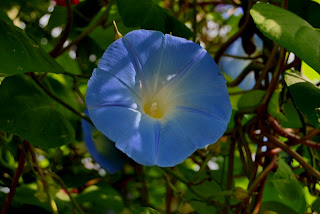The mountains & the lake, people & places, children & chickens, frescoes & felines, barbera & books.
Thursday, 21 October 2010
Gardener's question...
Anyone name this climber? They're everywhere here this year, but my long-suffering neighbours have failed to help me understand or deduce what its name is. Perhaps because its almost plastic blue is totally out of step with the golds, yellows and browns of the season, it's a real autumn eyecatcher along the SS34 Lago Maggiore road, and maybe one might also be nice climbing a Carmine fence next year...
Thursday, 21 October 2010
Gardener's question...
Anyone name this climber? They're everywhere here this year, but my long-suffering neighbours have failed to help me understand or deduce what its name is. Perhaps because its almost plastic blue is totally out of step with the golds, yellows and browns of the season, it's a real autumn eyecatcher along the SS34 Lago Maggiore road, and maybe one might also be nice climbing a Carmine fence next year...
9 comments:
- Martha said...
-
In the US this is called a morning glory and are thought of as being invasive.
-
Thursday, 21 October, 2010

-
Anonymous said...

-
Hi Louise,
I look it for an "Blue Rock Bindweed" Convolvulus sabatius.
It's part of italys flora and sometimes cultivated in gardens for his blue.
joachim -
Thursday, 21 October, 2010

- LindyLouMac said...
-
I know this as Morning glory as well.
-
Thursday, 21 October, 2010

- Gutsy Living said...
-
Yes, We have them growing against our fence, from the other side. They are pretty though.
-
Thursday, 21 October, 2010

- Karin said...
-
Looks like a morning glory to me! Very interesting shade of blue!
-
Friday, 22 October, 2010

-
Woodman said...

-
Just another weed which climbs up anything available. Its a pest to get rid of so don't introduce it to your garden.
-
Friday, 22 October, 2010

-
choir girl said...

-
Hi - yes its morning glory - a real menace in my english garden but mine is white and called convulvulus. Its a pernicious weed which spreads via underground roots which grow from even small amounts of root so pulling them up doesn't rid you of them. They twine round all your plants and ruin the flower beds! Their only saving grace here is that they are annuals but appear in great numbers in spring. I fight a constant battle to stop them taking over.
-
Friday, 22 October, 2010

- Blondi Blathers said...
-
In Saskatchewan (Canada) the morning glory has to be started indoors in the spring or purchased as a bedding plant from the local greenhouses in order to be planted out in the garden or against the house. They do not survive the winter and do not take over like a weed, as they do in places like, oh, California I'm guessing.
-
Saturday, 23 October, 2010

- Lee said...
-
Yep. Morning Glory south of the equator too.
-
Sunday, 24 October, 2010


9 comments:
In the US this is called a morning glory and are thought of as being invasive.
Hi Louise,
I look it for an "Blue Rock Bindweed" Convolvulus sabatius.
It's part of italys flora and sometimes cultivated in gardens for his blue.
joachim
I know this as Morning glory as well.
Yes, We have them growing against our fence, from the other side. They are pretty though.
Looks like a morning glory to me! Very interesting shade of blue!
Just another weed which climbs up anything available. Its a pest to get rid of so don't introduce it to your garden.
Hi - yes its morning glory - a real menace in my english garden but mine is white and called convulvulus. Its a pernicious weed which spreads via underground roots which grow from even small amounts of root so pulling them up doesn't rid you of them. They twine round all your plants and ruin the flower beds! Their only saving grace here is that they are annuals but appear in great numbers in spring. I fight a constant battle to stop them taking over.
In Saskatchewan (Canada) the morning glory has to be started indoors in the spring or purchased as a bedding plant from the local greenhouses in order to be planted out in the garden or against the house. They do not survive the winter and do not take over like a weed, as they do in places like, oh, California I'm guessing.
Yep. Morning Glory south of the equator too.
Post a Comment